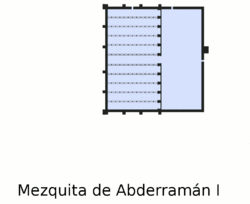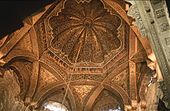Mezquita-Catedral de Córdoba
The Mezquita-Catedral de Córdoba ("Mosque-Cathedral of Córdoba"), often simply called the Mosque of Córdoba ( Mezquita de Córdoba ), also known in German as the Cathedral Mosque of Córdoba , has been the Roman Catholic cathedral in Córdoba since the Reconquista . Mezquita is the Spanish word for mosque , from Arabic مسجد Masjid , DMG Masǧid [ masdʒid ]. As the episcopal church of the diocese of Córdoba it is called Catedral de Nuestra Señora de la Asunción ("Cathedral of the Assumption of Mary ").
The building has its architectural world renown as the former main mosque - al-Jāmiʿ al-kabīr / Jāmiʿ Qurṭuba - from the era of Moorish Spain . The huge oratory is by horseshoe arches in 19 approximately equal to high vessels with up to 36 Jochen divided. It was expanded again and again in several construction phases by the emirs and caliphs of Córdoba . With around 23,000 m², the building is one of the largest former mosques in the world. In the 16th century a Gothic nave was built into the hall and the minaret was replaced by a bell tower . The Mezquita-Catedral has been a UNESCO World Heritage Site since 1984 .
Building
Today the cathedral is 179 m long and 134 m wide. It covers an area of more than 23,000 m², making it one of the largest sacred buildings on earth. The prayer hall takes up almost two thirds of the area. In the understanding of early Islam, the court was no less a place of prayer.
The most impressive feature of the prayer hall is the superimposed horseshoe arches that rest on 856 columns made of jasper , onyx , marble and granite . Most of the columns come from buildings from Roman times , both from the Roman temple that had previously been on this site and from other Roman buildings from the Baetica province . They create the impression of a delimitation towards the top, just as the large number of ships crossing each other creates an impression of infinity in the horizontal. The main axis of the mosque points to the south-southeast, i.e. not exactly to Mecca . Since the last extension of the hall and forecourt was only possible to the side, the mihrab is no longer in the central axis, and the hall - not the entire building - is wider than it is long. There are three small domes above the square in front of the mihrab. The main mosque of Córdoba did not have a dominating central dome like many, especially younger, mosques.
The main axis of the church, built in the middle of the prayer hall in the 16th century , lies transversely to that of the mosque and faces east-north-east. It is a basilica in the shape of a Latin cross with a crossing dome . The church building extends over ten aisles and twelve yokes of the mosque vault, so it is about half as long as the mosque and a third as wide as the prayer hall.
history
The place where the cathedral is located was used for religious practice as early as the Roman Empire . There was a Roman temple there , then a Visigoth cathedral for Saint Vincent of Saragossa . According to the Islamic historian al Razi from the 9th century, after the conquest of Cordoba in the middle of the 8th century, all previous churches in the city were destroyed, only the cathedral was left standing and divided between Muslims and Christians. When there was no longer enough space for the Muslims, the Emir Abd ar-Rahman I urged the Christians to give up this church by paying a large sum of money and allowing them to build churches outside the city. He then had the entire building torn down in 784 and the construction of the new mosque began. The historicity of this narrative is not certain, however.
Build as a mosque
Construction of the mosque began in 784 under the supervision of Abd ar-Rahman I, the first Umayyad emir of Córdoba . It was expanded over the next two centuries. Under Abd ar-Rahman II, it was necessary to enlarge the originally 11-aisled prayer room. Abd ar-Rahman III. commissioned a new minaret and enlarged the mosque courtyard, al-Hakam II expanded the building and equipped the mihrab with new elements. The columns standing up in the prayer room are spolia ; the arches that exist today to highlight individual prayer hall areas were only used in the construction phase under Al-Hakam II.
The building reached its current size in 987/988 with the expansion of the outer aisles and the orange courtyard (Spanish: Patio de Naranjas ) by the vizier al-Mansur ibn Abi Amir . The Mezquita was the most magnificent of the city's mosques . Córdoba was conquered frequently in the centuries that followed, and architectural changes followed each conquest.
Rededication to the church
1236, the same year that Ferdinand III. of Castile Córdoba was recaptured from the Moors, the mosque was consecrated as a church and the minaret was given a cross. The arcades open to the courtyard were closed. Alfonso X commissioned the construction of the Villaviciosa chapel and the royal chapel. The kings who followed him also added to the church.
In the first two and a half centuries, however, it was limited to smaller installations and conversions. It was not until Bishop Don Íñigo Manrique (1486–1496) propagated the installation of a Gothic nave . In the last year of the reign of the fourth bishop after him, Don Alonso Manrique, the decisive renovation began in 1523, against the energetic resistance of the city council of Córdoba, but with the approval of the Habsburg emperor Charles V (Charles I of Spain). The pillars were removed in the middle part to make room for a church building in the Plateresque style . It was completed in 1607 under the bishop Diego de Mardones. From 1593 to 1664, the minaret was also replaced by a bell tower.
When Charles V saw the result on a visit to Córdoba in 1526, he is said to have said: “I didn't know what this was about. Because if I had known, I would not have allowed anyone to lay hands on the old building. You have done what was possible, built something that already exists elsewhere, and in return you destroyed something that was unique in the world ”. It is not certain, however, whether this statement can really be ascribed to Karl.
The Bishop of Cordoba , Juan José Asenjo , spoke out in 2006 against converting the cathedral into an interfaith church. He justified this with the archaeological evidence that the mosque was built over the foundations of a Visigoth cathedral. Therefore, a - even partial - conversion of the cathedral back into a mosque should be rejected.
organ
The organ of the cathedral was built in 1702 by the organ builder José Martínez Colmenero. The instrument was last restored in 1998 by the organ builder Organería Acitores.
The instrument is divided into bass and treble side and has 25 registers on the bass side and 29 registers on the treble side, plus 2 registers in the pedal . The key range of the manuals is 49 tones.
|
|
|
|
||||||||||||||||||||||||||||||||||||||||||||||||||||||||||||||||||||||||||||||||||||||||||||||||||||||||||||
literature
- Luis Alvarez Moreno: The Mosque La Mezquita de Córdoba. Ed. Intuco, Granada 1999.
- Rafael Castejon y Martinez de Arizala: The Mosque of Cordoba. Editorial Everest, Leon 1973.
- Christian Ewert : Research on the Almohad mosque. Preliminary stages. Hierarchical structure of western Islamic prayer halls from the 8th to 11th centuries: the main mosques of Qairawān and Córdoba and their spell. Philipp von Zabern, Mainz 1981, ISBN 3-8053-0471-4 .
- Heinrich Gerhard Franz : The former mosque in Córdoba and the two-storey arch arrangement in Moorish architecture. In: Heinrich Finke (ed.): Collected essays on the cultural history of Spain. Vol. 13. Aschendorff, Münster / Westphalia 1958, pp. 171–187.
- Francine Giese-Vögeli: The mosque of Córdoba between east and west. In: Madrid Communications. 50, 2009, ISSN 0418-9744 , pp. 524-537.
- Karoline Gimpl: Andalusia. From Seville's Gothic cathedral to the Moorish mosque of Cordoba and the magnificent Alhambra of Granada. (= DuMont art travel guide ). 2nd Edition. DuMont-Reiseverlag, Ostfildern 2012, ISBN 978-3-7701-6620-6 .
- Manuel Salcines: The Cordobas Mosque. Ed. Escudo de Oro, Barcelona 1996, ISBN 84-378-1746-3 .
- Henri Stern : Les mosaïques de la grande mosquee de Cordoue (= Madrid Researches 11). De Gruyter, Berlin 1976, ISBN 3-11-002126-9 .
Web links
- The Mosque of Cordoba shown by historians (Spanish)
- Pictures of the Mezquita de Córdoba (German)
Individual evidence
- ^ Ann Christys: The meaning of topography in Umayyad Córdoba. In: Caroline Goodson, Anne E. Lester, Carol Symes (Eds.): Cities, Texts and Social Networks, 400–1500. Routledge, Farnham 2010, pp. 103-124 (e-book edition). The English translation of the historical text can be found in Jarbel Rodriguez (Ed.): Muslim and Christian Contact in the Middle Ages. A Reader (= Readings in Medieval Civilizations and Cultures. Volume 18). University of Toronto Press, Toronto 2015 (e-book edition).
- ↑ Christian Ewert: Research on the Almohad mosque 1. Preliminary stages: hierarchical structures of western Islamic prayer rooms from the 8th to 11th centuries: the main mosques of Qairawan and Córdoba and their spell. Philipp von Zabern, Mainz 1981, p. 30.
- ↑ Vatican Radio : Spain: Against the Mosque Church ( Memento of October 7, 2007 in the Internet Archive ), December 28, 2006
- ↑ Information on the organ ( Memento from August 27, 2014 in the Internet Archive ).
Coordinates: 37 ° 52 ′ 45 " N , 4 ° 46 ′ 47" W.







